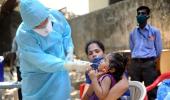Scientists have shown that a variation in the genome of the novel coronavirus has improved its ability to infect human cells, and has helped it become the dominant strain circulating around the world.

According to the research, published in the journal Cell, a variant of the novel coronavirus, named 'D614G', is more infectious in cell cultures under laboratory conditions.
"The D614G variant first came to our attention in early April, as we had observed a strikingly repetitive pattern," said study lead author Bette Korber from the Los Alamos National Laboratory in the US.
"All over the world, even when local epidemics had many cases of the original form circulating, soon after the D614G variant was introduced into a region it became the prevalent form," Korber said.
The researchers, including those from the University of Sheffield in the UK, said D614G has a small but effective change in the 'spike' protein that protrudes from the surface of the virus, which it uses to enter and infect human cells.
They said this variant has quickly taken over as the dominant strain soon after it first appeared, with geographic samples showing a significant shift in viral population from the original, to the new strain of the virus.
"We have been sequencing SARS-CoV-2 strains in Sheffield since early in the pandemic and this allowed us to partner with our collaborators to show this mutation had become dominant in circulating strains," said study co-author Thushan de Silva, who led the analysis of data from Sheffield.
"The full peer-reviewed study published today confirms this, and also that the new D614G genome mutation variant is also more infectious under laboratory conditions," he added.
According to the scientists, the new strain is associated with higher viral loads in the upper respiratory tract of patients with COVID-19, meaning the virus's ability to infect people could be increased.
"Fortunately at this stage, it does not seem that viruses with D614G cause more severe disease," de Silva said.
The researchers said it is possible to track the evolution of the novel coronavirus globally thanks to the viral sequence data made readily available by scientists from across the world.
They said geographic information from these samples enabled tracking of a highly recurrent pattern, where soon after D614G was introduced into a region it became the prevalent form.
According to the study, there was a shift in the viral population from the original form to the D614G variant, occurring at every geographic level -- country, subcountry, county, and city.
"Currently tens of thousands of sequences are available through this project, and this enabled us to identify the emergence of a variant that has rapidly become the globally dominant form," Korber said.
The researchers cautioned that further laboratory analysis in live cells needs to be done to determine the full implications of the mutation.
They said the virus has a low mutation rate overall, adding that the D614G variant appears to have risen as part of a set of four linked mutations which may have arisen once and then moved together globally consistent variations.
"That this increase in infectivity was detected by careful observation of sequence data alone, and that our experimental colleagues could confirm it with live virus in such a short time," said Will Fischer from Los Alamos National Laboratory, a co-author author on the study.










